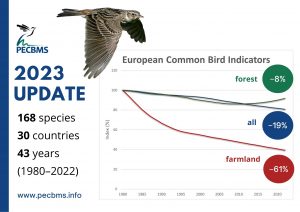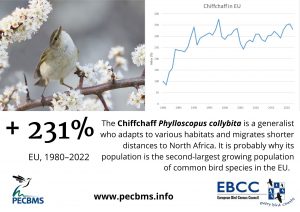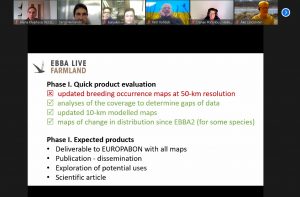Report on the Pan-European Common Bird Monitoring Scheme, March 2024
March 29, 2024
This report summarises the Pan-European Common Bird Monitoring Scheme (PECBMS) activities between 1 September 2023 and 15 March 2024.
Summary
We finished the strategic planning and introduced the plan to the PECBMS Steering and Technical Group. We released the 2023 update of supra-national European species trends and indicators on 11th December. The update covers 43 years from 30 countries, including 26 EU MS – all but Malta, where, however, a regular bird monitoring scheme started in 2023, and we plan to include their data in the near future. We updated the network with regular newsletters and web articles and connected via social media. Regularly, we met EU stakeholders, researchers and coordinators and provided answers and advice upon request. To give feedback to the coordinators, we organised two online webinars. The first occurred in January and was dedicated to the EBBA Live Farmland project; the second was the fourth, already traditional, technical webinar in March. We attended a conference, a workshop and regular EBCC Board meetings, where we presented the progress of the PECBMS. In November, we successfully won the bid, and in late December, we started working on a new EC contract, which will secure the scheme until 2026. Moreover, we established a new working group to develop a novel mountain bird indicator.
Project funding
The project is funded by the EC tender called “Service Contract for providing technical and scientific support in relation to the delivery and development of wild bird indicators for the EU (2023–2026)“. The consortium of this contract includes the following partners:
CSO (Czechia), RSPB (UK), ICO (Spain), CREAF (Centro de Investigacion Ecologica y Aplicaciones Forestales, Spain), IREC-CSIC (Instituto de Investigacion en Recursos Cinegeticos, Spain)
The main deliverables under this contract are as follows:
- Yearly updates of the EU-level population size, indices and trends for 170 bird species
- Yearly updates of three existing EU-level bird indicators
- Development of a novel EU-level Urban bird indicator
- Flyway-specific trends for a selected group of (at least 5) common long-distance migratory
bird species
- Assistance in establishing a new dedicated EC webpage for publishing the contract outputs
- A scientific publication
- A meeting with stakeholders’ representatives to clarify the methods, data availability and any other issues
- Inception report, 2 Progress reports, Final report
In addition to this contract, the PECBMS is involved in several other projects and cooperates with researchers interested in the PECBMS data, for which we receive data handling fees. This way, we aim to achieve sustainable scheme funding from variable sources.
Production of European species trends and European and EU indicators
On 11 December 2023, we published trends and indices of 170 common European bird species for 1980–2022 based on data from 30 countries. The outputs were computed for 1980–2022 and the last ten years (2013–2022). This way, we kept the delays in data delivery to one year (in contrast to the previous 2-year delay). We used data till 2022 for most countries; the only exceptions were France and Slovakia, for which we used the same indices as the previous year (till 2021). At the same time, we published the European Common Bird Indicators 2022 update based on data from 30 countries (1980–2022). All supranational outputs are freely available to download at the PECBMS website.
We used the single European species habitat classifications to assess whether each bird species belongs to farmland, forest, or another indicator.

Fig. 1 European Common Bird Indicators (1980–2022). All common species (168), shown in the blue line, declined by 19%; common forest species (34), shown in the green line, declined by 8%; and common farmland species (39), shown in the red line, decreased by an alarming 61%.
Technical improvements
Most national coordinators calculate national indices using an updated version of a tool called RTRIM-shell (developed in Statistics Netherlands). The tool uses the RTRIM package in R to produce the same outputs as previous indicator updates. In March, the latest version, RTRIM-shell 2.0 has been released. Javier Rivas Salvador developed this version in cooperation with national coordinators. We aim to create it in the most friendly way possible for users. The main advantage of the new version is that we merged all the previous scripts into one script, which – in one run – enables us to prepare the input data, run RTRIM calculation and prepare the results for upload in the PECBMS online tool.
National data (both national indices and site-level data) are regularly delivered via the PECBMS Online tool. During the last several months, we merged the Online tool intended for the national indices into a Site-level online tool to make a unique home for both PECBMS projects.
The R-based tool the PECBMS coordination team used for calculating supranational species indices (RSWAN) has also been updated. It helps us speed up the combination of national schemes with a country and the combination of country indices into supranational results, enlarging the set of calculated results.
Presentation of results and promotion
We informed the national coordinators and the wider audience, comprising 660 contacts, on the progress of the PECBMS via reports in the quarterly electronic EBCC Newsletter (Autumn and Winter issues 2023). All issues are available online on the pecbms.info website.

Fig. 2 Title pages of the EBCC newsletters
The PECBMS website, www.pecbms.info, has been updated regularly. We published 11 news articles in the given period and updated the list of publications, PECBMS methods, and information on the European bird monitoring schemes.
To address the wider public, we maintained the Facebook and Twitter profiles and updated the posts regularly—12 news items directly regarding the PECBMS from 1 September 2022 to 29 February 2024.


Fig. 3 Infographics used to promote the PECBMS outputs via website and social media
A Novel Mountain Bird Indicator development
We started developing a novel indicator of mountain birds based on the PECBMS site-level data. So far, mountain bird indicators have been produced in the UK (Upland bird index), Sweden, Finland (alpine bird index), Norway and Italy (mountain grassland index). We established a working group comprising the PECBMS core team, Arco van Strien and Aleksi Lehikoinen, which met in October 2023 and February 2024. We plan to build the Mountain indicator on the publication by Lehikoinen et al. 2019 (Global Change Biology) Declining population trends of European mountain birds (pecbms.info) and produce the indicator once every 3–5 years, depending on the site-level database updates. Colleagues interested in the mountain bird index development are invited to join the working group. We plan to keep working on the indicator development in 2024.
Research
The PECBMS data has been used in several studies. Site-level data on 50 farmland birds has been involved in the EBBA2 Live project, which attempts to update EBBA2 maps of farmland birds (period 2013–2017) with maps based on PECBMS data (2018–2023).
The PECBMS team represented EBCC at two conferences and workshops. From 28–29 September, the Conference Migratory Birds and Climate Change occurred in Criewen, Germany. Anna Gamero gave a talk on the Long-term trends of European migratory birds. From 22–25 November, the Training workshop on International Census Plots (ICP) and online portals was arranged in Brno, Czechia. The PECBMS team members attended in person, and Alena Klvaňová gave a talk on the PECBMS data in science and conservation.
In December, we updated the continent-wide population size changes “Long-term and large-scale multispecies dataset tracking population changes of common European breeding birds” in the Zenodo repository, supplementing the data paper published in 2020.
Maintain and update the network of cooperating organisations and individuals.
We provided advice and consultations to the national coordinators upon request.
Slovakia: We discussed the details of the country’s recently established monitoring scheme.
Malta: We met BirdLife Malta colleagues to discuss funding bird monitoring in Malta and possibly joining the PECBMS. We assisted in communicating with the Government to get funding for the regular monitoring scheme to enable farmland bird indicator production. Unfortunately, the call for tenders was opened only for a 1-year project, and another organisation won the bid.
Croatia: We discussed the newly established schemes dedicated to forest birds, which will produce national forest bird indicators. We also met with the government and BIOM (Croatian BirdLife Partner) to discuss the methodology and production of the new indicator.
Germany: We discussed data delivery for former East and West parts of Germany, which PECBMS needs to compute for East and West Europe data.
Cyprus: We discussed the use of the RTRIM shell.
In cooperation with Sergi Herrando, we arranged the EBBA Live Farmland webinar on 31 January for the coordinators who provided the project data. Fifty-four participants attended the 2-hour webinar; the recording and presentation are available in the pdf.

Fig. 4 Sergi Herrando´s presentation of the EBBA Live Farmland results
On 7 March, we organised the third PECBMS webinar (via Zoom) dedicated to the new RTRIM shell 2.0 and the upgrade of the Online tool. Eva Šilarová guided the national coordinators from the data preparation to data validation in the online tool. Anna Gamero introduced the news using the site-level online data tool. Altogether, 44 participants, mainly national coordinators, attended the event. The recording is available.

Fig. 5 Anna Gamero´s presentation on the Site-level ONLT
Active communication with the scheme stakeholders
- EBCC office meetings (monthly)
- PECBMS department meetings (monthly)
- Technical meetings within the team (twice a year), incl. experts
- regular meetings and e-mail communication with DG ENV EU nature restoration law
- Regular meetings with DG ENV
- Kick-off meeting and Inception meeting with the new contract Steering Group (DG ENV, DG Agri, JRC, EEA)
- Eurostat
- Communication with the EC officers regarding the new Nature Restoration Law and informing them about the outputs of the survey among the national coordinators on the production of national bird indicators
- Two meetings with the PECBMS Steering and Technical Group
Reporting to the EBCC Board
We regularly attended EBCC Board meetings online from 18–19 Oct. and 22 Feb., where we presented the PECBMS progress and main outputs for the given periods.
